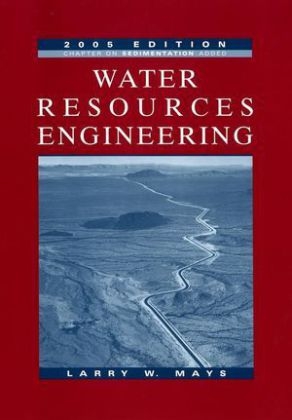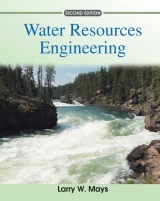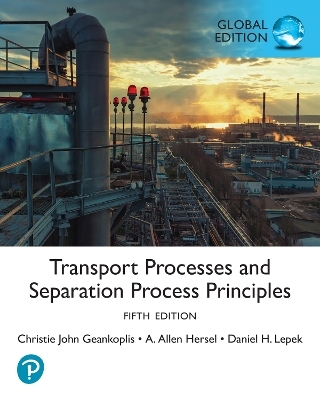
Water Resources Engineering
John Wiley & Sons Inc (Verlag)
978-0-471-70524-6 (ISBN)
- Titel ist leider vergriffen;
keine Neuauflage - Artikel merken
Learn the principles and practice of water resources engineering from a leader in the field! Now updated with a new chapter on sedimentation (Chapter 18), this 2005 Edition of Larry Mays's Water Resources Engineering provides you with the state-of-the-art in the field. With remarkable range and depth of coverage, Professor Mays presents a straightforward, easy-to-understand presentation of hydraulic and hydrologic processes using the control volume approach. He then extends these processes into practical applications for water use and water excess, including water distribution systems, stormwater control, and flood control. With its strong emphasis on analysis and design, this text will be a resource you'll refer to throughout your career! Features:* New! A new chapter covers sedimentation.* Practical applications will prepare you for engineering practice.* Coverage spans an extraordinary range of topics.* Many example problems with solutions will help you hone your problem-solving skills.* Practice problems at the end of each chapter offer you the opportunity to apply what you've learned.
* Includes a review of basic fluid concepts and the control volume approach to fluid mechanics.
Larry W. Mays is Professor of Civil and Environmental Engineering at Arizona State University and former chair of the department. He was formerly Director of the Center for Research in Water Resources at The University of Texas at Austin, where he also held an Engineering Foundation Endowed Professorship. A registered professional engineer in seven states and a registered professional hydrologist, he has served as a consultant to many organizations. He was the editor-in-chief of Reliability Analysis of Water Distribution Systems (ASCE) and co-editor of Computer Modeling of Free Surface and Pressurized Flows. Among his honors include a distinguished alumnus award from the University of Illinois at Urbana-Champaign in 1999.
Chapter 1. Introduction. 1.1 Background. 1.2 The Worlda s FreshWater Resources. 1.3 Water Use in the United States. 1.4 Systems of Units. 1.5 What Is Water? 1.6 The Future of Water Resources. Chapter 2. Principles of Flow in Hydrosystems. 2.1 Properties Involving Mass or Weight of Water. 2.2 Viscosity. 2.3 Elasticity. 2.4 Pressure and Pressure Variation. 2.5 Surface Tension. 2.6 Flow Visualization. 2.7 Laminar and Turbulent Flow. 2.8 Discharge. Chapter 3. Flow Processes and Hydrostatic Forces. 3.1 Control Volume Approach for Hydrosystems. 3.2 Continuity. 3.3 Energy. 3.4 Momentum. 3.5 Pressure and Pressure Forces in Static Fluids. 3.5.1 Hydrostatic Forces. 3.5.2 Buoyancy. 3.6 Velocity Distribution. Chapter 4. Hydraulic Processes: Pressurized Pipe Flow. 4.1 Classification of Flow. 4.2 Pressurized (Pipe) Flow. 4.2.1 Energy Equation. 4.2.2 Hydraulic and Energy Grade Lines. 4.3 Headlosses. 4.3.1 Shear-Stress Distribution of Flow in Pipes. 4.3.2 Velocity Distribution of Flow in Pipes. 4.3.3 Headlosses from Pipe Friction. 4.3.4 Form (Minor) Losses. 4.4 Forces in Pipe Flow. 4.5 Pipe Flow in Simple Networks. 4.5.1 Series Pipe Systems. 4.5.2 Parallel Pipe Systems. 4.5.3 Branching Pipe Flow. 4.6 Measurement of Flowing Fluids in Pressure Conduits. 4.6.1 Measurement of Static Pressure. 4.6.2 Measurement of Velocity. 4.6.3 Measurement of Discharge. Chapter 5. Hydraulic Processes: Open-Channel Flow. 5.1 Steady Uniform Flow. 5.1.1 Energy. 5.1.2 Momentum. 5.1.3 Best Hydraulic Sections for Uniform Flow in Nonerodible Channels. 5.2 Specific Energy, Momentum, and Specific Force. 5.2.1 Specific Energy. 5.2.2 Momentum. 5.2.3 Specific Force. 5.3 Steady, Gradually Varied Flow. 5.3.1 Gradually Varied Flow Equations. 5.3.2 Water Surface Profile Classification. 5.4 Gradually Varied Flow for Natural Channels. 5.4.1 Development of Equations. 5.4.2 Energy Correction Factor. 5.4.3 Application for Water Surface Profile. 5.5 Rapidly Varied Flow. 5.6 Discharge Measurement. 5.6.1 Weir. 5.6.2 Flumes. 5.6.3 Stream Flow Measurement: Velocity-Area-Integration Method. Chapter 6. Hydraulic Processes: Groundwater Flow. 6.1 Groundwater Concepts. 6.2 Saturated Flow. 6.2.1 Governing Equations. 6.2.2 Flow Nets. 6.3 Steady-State One-Dimensional Flow. 6.4 Steady-State Well Hydraulics. 6.4.1 Flow to Wells. 6.4.2 Confined Aquifers. 6.4.3 Unconfined Aquifers. 6.5 Transient Well Hydraulicsa Confined Conditions. 6.5.1 Nonequilibrium Well Pumping Equation. 6.5.2 Graphical Solution. 6.5.3 Coopera Jacob Method of Solution. 6.6 Transient Well Hydraulicsa Unconfined Conditions. 6.7 Transient Well Hydraulicsa Leaky Aquifer Conditions. 6.8 Boundary Effects: Image Well Theory. 6.8.1 Barrier Boundary. 6.8.2 Recharge Boundary. 6.8.3 Multiple Boundary Systems. 6.9 Simulation of Groundwater Systems. 6.9.1 Governing Equations. 6.9.2 Finite Difference Equations. 6.9.3 MODFLOW. Chapter 7. Hydrologic Processes. 7.1 Introduction to Hydrology. 7.1.1 What Is Hydrology? 7.1.2 The Hydrologic Cycle. 7.1.3 Hydrologic Systems. 7.1.4 Atmospheric and Ocean Circulation. 7.2 Precipitation (Rainfall). 7.2.1 Precipitation Formation and Types. 7.2.2 Rainfall Variability. 7.2.3 Disposal of Rainfall on a Watershed. 7.2.4 Design Storms. 7.2.5 Estimated Limiting Storms. 7.3 Evaporation. 7.3.1 Energy Balance Method. 7.3.2 Aerodynamic Method. 7.3.3 Combined Method. 7.4 Infiltration. 7.4.1 Unsaturated Flow. 7.4.2 Greena Ampt Method. 7.4.3 Other Infiltration Methods. Chapter 8. Surface Runoff. 8.1 Drainage Basins. 8.2 Hydrologic Losses and Rainfall Excess. 8.3 Rainfall-Runoff Analysis Using Unit Hydrograph Approach. 8.4 Synthetic Unit Hydrographs. 8.5 S-Hydrographs. 8.6 SCS Rainfall-Runoff Relation . 8.7 Curve Number Estimation and Abstractions. 8.7.1 Antecedent Moisture Conditions. 8.7.2 Soil Group Classification. 8.7.3 Curve Numbers. 8.8 SCS Unit Hydrograph Procedure. 8.8.1 Time of Concentration. 8.8.2 Time to Peak. 8.8.3 Peak Discharge. 8.9 Kinematic-Wave Overland Flow Runoff Model. 8.10 Computer Models for Rainfall-Runoff Analysis. Chapter 9. Reservoir and Stream Flow Routing. 9.1 Routing. 9.2 Hydrologic Reservoir Routing. 9.3 Hydrologic River Routing. 9.4 Hydraulic (Distributed) Routing. 9.4.1 Unsteady Flow Equations: Continuity Equation. 9.4.2 Momentum Equation. 9.5 Kinematic Wave Model for Channels. 9.5.1 Kinematic Wave Equations. 9.5.2 U.S. Army Corps of Engineers HEC-1 Kinematic Wave Model for Overland Flow and Channel Routing. 9.5.3 KINEROS Channel Flow Routing Model. 9.5.4 Kinematic Wave Celerity. 9.6 Muskingum-Cunge Model. 9.7 Implicit Dynamic Wave Model. Chapter 10. Probability, Risk, and Uncertainty Analysis for Hydrologic and Hydraulic Design. 10.1 Probability Concepts. 10.2 Commonly Used Probability Distributions. 10.2.1 Normal Distribution. 10.2.2 Log-Normal Distribution. 10.3 Hydrologic Design for Water Excess Management. 10.3.1 Hydrologic Design Scale. 10.3.2 Hydrologic Design Level (Return Period). 10.3.3 Hydrologic Risk. 10.3.4 Hydrologic Data Series. 10.4 Hydrologic Frequency Analysis. 10.5 U.S Water Resources Council Guidelines for Flood Flow Frequency Analysis. 10.5.1 Procedure. 10.5.2 Testing for Outliers. 10.6 Analysis of Uncertainties. 10.7 Risk Analysis: Composite Hydrologic and Hydraulic Risk. 10.7.1 Reliability Computation by Direct Integration. 10.7.2 Reliability Computation Using Safety Margin/Safety Factor. 10.8 Computer Models for Floodflow Frequency Analysis. Chapter 11. Water Withdrawals and Uses. 11.1 Water-Use Dataa Classification of Uses. 11.2 Water for Energy Production. 11.3 Water for Agriculture. 11.3.1 Irrigation Trends and Needs. 11.3.2 Irrigation Infrastructure. 11.3.3 Irrigation System Selection and Performance. 11.3.4 Water Requirements for Irrigation. 11.3.5 Impacts of Irrigation. 11.4 Water Supply/Withdrawals. 11.4.1 Withdrawals. 11.4.2 Examples of Regional Water Supply Systems. 11.5 Water Demand and Price Elasticity. 11.5.1 Price Elasticity of Water Demand. 11.5.2 Demand Models. 11.6 Drought Management. 11.6.1 Drought Management Options. 11.6.2 Drought Severity. 11.6.3 Economic Aspects of Water Shortage. 11.7 Analysis of Surface Water Supply. 11.7.1 Surface-Water Reservoir Systems. 11.7.2 Storagea Firm Yield Analysis for Water Supply. 11.7.3 Reservoir Simulation. Chapter 12. Water Distribution. 12.1 Introduction. 12.1.1 Description, Purpose, and Components of Water Distribution Systems. 12.1.2 Pipe Flow Equations. 12.2 System Components. 12.2.1 Pumps. 12.2.2 Pipes and Fittings. 12.2.3 Valves. 12.3 System Configuration and Operation. 12.4 Hydraulics of Simple Networks. 12.4.1 Series and Parallel Pipe Flow. 12.4.2 Branching Pipe Flow. 12.5 Pump Systems Analysis. 12.5.1 System Head Curves. 12.5.2 Pump Operating Point. 12.5.3 System Design for Water Pumping. 12.6 Network Simulation. 12.6.1 Conservation Laws. 12.6.2 Network Equations. 12.6.3 Network Simulation: Hardya Cross Method. 12.6.4 Network Simulation: Linear Theory Method. 12.6.5 Extended-Period Simulation. 12.7 Modeling Water Distribution Systems. 12.7.1 Computer Models. 12.7.2 Calibration. 12.7.3 Application of Models. 12.7.4 Water Quality Modeling. 12.8 Hydraulic Transients. 12.8.1 Hydraulic Transients in Distribution Systems. 12.8.2 Fundamentals of Hydraulic Transients. 12.8.3 Control of Hydraulic Transients. Chapter 13. Water for Hydroelectric Generation. 13.1 Role of Hydropower. 13.2 Components of Hydroelectric Plants. 13.2.1 Elements to Generate Electricity. 13.2.2 Hydraulics of Turbines. 13.2.3 Power System Terms and Definitions. 13.3 Determining Energy Potential. 13.3.1 Hydrologic Data. 13.3.2 Water Power Equations. 13.3.3 Turbine Characteristics and Selection. 13.3.4 Flow Duration Method. 13.3.5 Sequential Streamflow-Routing Method. 13.3.6 Power Rule Curve. 13.3.7 Multipurpose Storage Operation. Chapter 14. Flood Control. 14.1 Introduction. 14.2 Floodplain Management. 14.2.1 Floodplain Definition. 14.2.2 Hydrologic and Hydraulic Analysis of Floods. 14.2.3 Floodways and Floodway Fringes. 14.2.4 Floodplain Management and Floodplain Regulations. 14.2.5 National Flood Insurance Program. 14.2.6 Stormwater Management and Floodplain Management. 14.3 Flood-Control Alternatives. 14.3.1 Structural Alternatives. 14.3.2 Nonstructural Measures 542 14.4 Flood Damage and Net Benefit Estimation. 14.4.1 Damage Relationships. 14.4.2 Expected Damages. 14.4.3 Risk-Based Analysis. 14.5 U.S. Army Corps of Engineers Risk-Based Analysis for Flood-Damage Reduction Studies. 14.5.1 Terminology. 14.5.2 Benefit Evaluation. 14.5.3 Uncertainty of Stage-Damage Function. 14.6 Operation of Reservoir Systems for Flood Control. 14.6.1 Flood-Control Operation Rules. 14.6.2 Tennessee Valley Authority (TVA) Reservoir System Operation. Chapter 15. Stormwater Control: Storm Sewers and Detention. 15.1 Stormwater Management. 15.2 Storm Systems. 15.2.1 Information Needs and Design Criteria. 15.2.2 Rational Method Design. 15.2.3 Hydraulic Analysis of Designs. 15.2.4 Storm Sewer Appurtenances. 15.2.5 Risk-Based Design of Storm Sewers. 15.3 Stormwater Drainage Channels. 15.3.1 Rigid-Lined Channels. 15.3.2 Flexible-Lined Channels. 15.4 Stormwater Detention. 15.4.1 Why Detention? Effects of Urbanization. 15.4.2 Types of Surface Detention. 15.4.3 Sizing Detention. 15.4.4 Detention Basin Routing. 15.4.5 Subsurface Disposal of Stormwater. Chapter 16. Stormwater Control: Street and Highway Drainage and Culverts. 16.1 Drainage of Street and Highway Pavements. 16.1.1 Design Considerations. 16.1.2 Flow in Gutters. 16.1.3 Pavement Drainage Inlets. 16.1.4 Interception Capacity and Efficiency of Inlets on Grade. 16.1.5 Interception Capacity and Efficiency of Inlets in Sag Locations. 16.1.6 Inlet Locations. 16.1.7 Median, Embankment, and Bridge Inlets. 16.2 Hydraulic Design of Culverts. 16.2.1 Culvert Hydraulics. 16.2.2 Culvert Design. Chapter 17. Design of Spillways and Energy Dissipation for Flood Control Storage and Conveyance Systems. 17.1 Hydrologic Considerations. 17.2 Dams. 17.2.1 Type of Dams. 17.2.2 Hazard Classification of Dams. 17.2.3 Spillway Capacity Criteria. 17.2.4 Safety of Existing Dams. 17.2.5 Hydraulic Analysis of Dam Failures. 17.2.6 Examples of Dams and Spillways. 17.3 Spillways. 17.3.1 Functions of Spillways. 17.3.2 Overflow and Free-Overfall (Straight Drop ) Spillways. 17.3.3 Ogee (Overflow) Spillways. 17.3.4 Side Channel Spillways. 17.3.5 Drop Inlet (Shaft or Morning Glory) Spillways. 17.3.6 Baffled Chute Spillways. 17.3.7 Culvert Spillways. 17.4 Hydraulic-Jump Type Stilling Basins and Energy Dissipators. 17.4.1 Types of Hydraulic Jump Basins. 17.4.2 Basin I. 17.4.3 Basin II. 17.4.4 Basin III. 17.4.5 Basin IV. 17.4.6 Basin V. 17.4.7 Tailwater Considerations for Stilling Basin Design. 17.5 Other Types of Stilling Basins. 17.6 Gates and Valves. 17.6.1 Spillway Crest Gates. 17.6.2 Gates for Outlet Works. 17.6.3 Valves for Outlet Works. 17.7 Outlet Works. Chapter 18. Sedimentation and Erosion Hydraulics. 18.0 Introduction. 18.1 Properties of Sediment. 18.1.1 Size and Shape. 18.1.2 Measurement of Size Distribution. 18.1.3 Settling Analysis for Finer Particles. 18.1.4 Fall Velocity. 18.1.5 Density. 18.1.6 Other Important Relations. 18.2 Bed Forms and Flow Resistance. 18.2.1 Bed Forms. 18.2.2 Sediment Transport Definitions. 18.2.3 Flow Resistance. 18.3 Sediment Transport. 18.3.1 Incipient Motion. 18.3.2 Sediment Transport Functions. 18.3.3 Armoring. 18.4 Bed Load Formulas. 18.4.1 Duboys Formula. 18.4.2 Meyer-Peter and Muller Formula. 18.4.3 Schoklitsch Formula. 18.5 Suspended Load. 18.6 Total Sediment Load (Bed Material Load Formulas). 18.6.1 Colbya s Formula. 18.6.2 Ackers-White Formula. 18.6.3 Yanga s Unit Stream Power Formula. 18.7 Watershed Sediment Yield. 18.8 Reservoir Sedimentation. 18.9 Stream Stability at Highway Structures. 18.9.1 Factors that Affect Stream Stability. 18.9.2 Basic Engineering Analysis. 18.9.3 Countermeasures (Flow Control Structure) for Stream Instability. 18.9.4 Spurs. 18.9.5 Guide Banks (Spur Dikes). 18.9.6 Check Dams (Channel Drop Structures). 18.10 Bridge Scour. 18.10.1 Design Approach. 18.10.2 Contraction Scour. 18.10.3 Local Scour at Piers. 18.10.4 Live-Bed Scour at Abutments. Appendix A. Newton-Raphson Method. Finding the root for a single nonlinear equation. Application to Solve Manninga s Equation for Normal Depth. Finding the roots of a system of nonlinear equations. Index.
| Erscheint lt. Verlag | 5.11.2004 |
|---|---|
| Zusatzinfo | Illustrations, maps |
| Verlagsort | New York |
| Sprache | englisch |
| Maße | 211 x 253 mm |
| Gewicht | 1524 g |
| Einbandart | gebunden |
| Themenwelt | Technik ► Umwelttechnik / Biotechnologie |
| ISBN-10 | 0-471-70524-1 / 0471705241 |
| ISBN-13 | 978-0-471-70524-6 / 9780471705246 |
| Zustand | Neuware |
| Haben Sie eine Frage zum Produkt? |
aus dem Bereich



